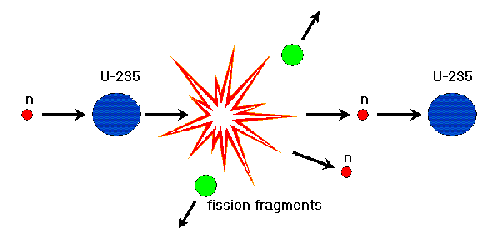
Basic Process - How Reactors Work
Fuel - Thermal Fission - Fission Fragments
The majority of nuclear reactors used in power plants world-wide are called thermal reactors because they use primarily thermal fission. Thermal neutrons (in red in figure below) "move in thermal equilibrium with the environment they are in." At a temperature of 550F, this corresponds to a velocity of about 3700 meters per second.
When these neutrons strike a uranium-235 nucleus (in blue in figure below) in the Fuel, sometimes the nucleus will split, or fission, into 2 unequally sized nuclei called fission fragments (in green in figure below). The fission products are large positively-charged particles of elements like Strontium or Iodine. These fission products slow down quickly in the fuel . They are the major contributor to heat production in the fuel (~80%). This heat gets transmitted to the coolant outside the fuel.
Also produced are between 2 and 3 neutrons (in red in figure below) at a very high energy. These neutrons must slow down to the thermal energy to increase the likelihood of causing further fissions.

Moderator
A Moderator is used to slow the neutrons down to the thermal energy. The neutrons usually do not travel very far in the reactor. They get produced from the fission in the fuel, bounce around a lot in the moderator and lose most of their energy, then cause fission (sometimes) or get absorbed in the fuel (and produce a more highly energized uranium isotope, which then decays into another material by gamma and/or beta decay).
Coolant
The purpose of the nuclear fission process is to produce heat. The fission fragments that are produced by the fission then slow down in the fuel losing most of their energy. The energy is converted to heat in the fuel. A Coolant is used to remove the heat and maintain the temperature of the fuel within acceptable limits. Sometimes the coolant is used to cool the moderator which, in turn, can be used to cool the fuel. Sometimes the coolant cools the fuel by passing around the rods containing the fuel. Sometimes the moderator and the coolant are the same material (e.g. water).
More on Fuel and Uranium Isotopes
The fuel in the reactor is in the form of pellets of either uranium metal or uranium dioxide. There are 2 or more uranium (U) isotopes (iso means same; p refers to the protons, i.e. isotopes are nuclides with the same number of protons, but different numbers of neutrons) - U-235 and U-238. U-238 is the most common form of uranium found in nature. It has 92 protons and 146 neutrons = total atomic mass number of 238. 99.27 % of uranium found in nature is U-238. The rest is U-235 (0.72%) and U-234 (0.0055%). In commercial reactors the fuel often has a higher concentration of U-235 than found in nature - typically 2 to 5%, compared to the 0.72% in nature. See the heavy water moderated reactor section for more on reactors with no enrichment. We say the fuel is enriched and the process used to make fuel with the higher U-235 levels is enrichment.
U-235 will undergo thermal and fast fission, i.e. it will likely fission when hit by neutrons of any energy - but not always; sometimes the neutron will bounce off (called scattering) and sometimes it will be absorbed by the U-235 (called absorption).
U-238 will only undergo fission when it is struck by faster neutrons of certain energies. Sometimes it will absorb neutrons of certain energies. When it does this, the U-238 will undergo a series of decays to form Plutonium-239 (Pu-239). When this happens, the Pu-239 may also fission with thermal neutrons. In the typical commercial reactor, Pu-239 is created and fissions throughout the period of a cycle. Just before the reactor is shutdown for refueling almost 30% of the power generated by the reactor may be due to the Pu-239.
In Europe, some countries, e.g. France, reprocess spent nuclear fuel. The plutonium is chemically separated from the spent fuel and used with U-235 and U-238 in the preparation of new fuel to be installed in the reactor. This type of fuel is referred to as Mixed Oxide Fuel, or MOX for short. Originally, breeder reactors had been planned to produce the Pu-239 for use in MOX fuels in the thermal reactors. Because of plutonium proliferation concerns, the reprocessing option was disallowed in the United States. At that time, the United States tried to halt all reprocessing of spent fuel world wide, since separated plutonium could be used to make atomic bombs. There are 2 schools of thought regarding plutonium proliferation - some as World Nuclear Association, EdF, and British Nuclear Fuels advocate the use of plutonium as an energy source. Others, as the Canadian Coalition for Nuclear Responsibility and the Nuclear Control Institute feel that the production of plutonium is a serious disadvantage of nuclear power as an energy source.
Links for Related Searches
Copyright © 1996-2006. The Virtual Nuclear Tourist. All rights reserved. Revised: December 20, 2005.